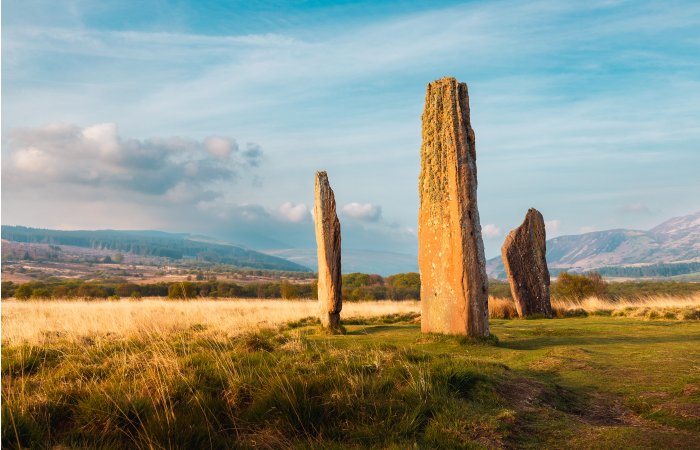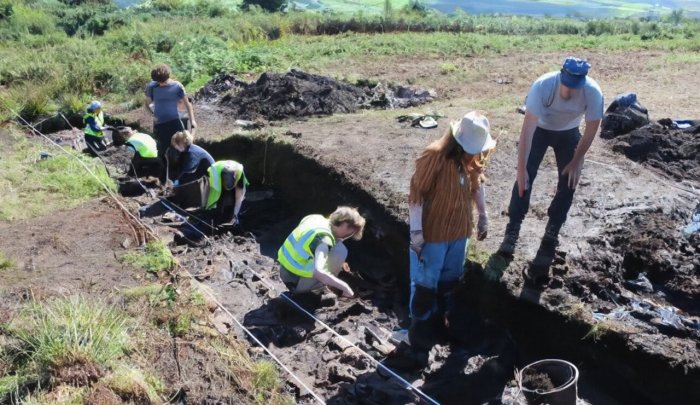Jan Bartek – AncientPages.com – A leading team of researchers have discovered what is believed to be a complete Neolithic cursus set within a rich prehistoric landscape on the Isle of Arran, Scotland.
This monument type is among the first that was built by farmers in Neolithic Britain and is huge—measuring 1.1km long and 50 meters wide.

Machrie Moor Standing Stones circle in golden evening light, Isle of Arran, Scotland. Credit: Adobe Stock – dropStock
A cursus is a vast Neolithic monument comprised of one or more rectangular enclosures. The cursus on Arran is defined by a large stone, earth and turf bank running around the entire perimeter of the enclosure. Constructing this monument would have involved staggering amounts of labor, transforming the entire local landscape.
This monument type could date to perhaps as early as 3500 BC, researchers say. It is the most complete example of this site type found in Britain and the opportunity to investigate a cursus bank is very rare and hugely exciting.
Prehistoric field boundaries, clearance cairns and round houses, at least some of which may be contemporary with the monument, have also found in the same landscape, all preserved within peatland, sealing the archaeological layers. Ancient soils representing the original Neolithic land surface, together with cultivated soils from the Bronze Age period, provide an unparalleled opportunity to understand how contemporary farming practice and settlement interacted with the cursus monument and how early farmers transformed this place.
The combination of investigating all these elements together is highly unusual. The inter-disciplinary team from the Universities of Glasgow, Reading, Birkbeck, Bournemouth, Coventry, Birmingham, and Southampton as well as archaeologists from Archaeology Scotland and Historic Environment Scotland, are using archaeological prospection, excavation and geoarchaeology, coupled with cutting-edge environmental scientific techniques, including ancient DNA, to understand how this unique landscape was constructed and used.
This research will provide invaluable information about landscape history and past ecosystems that will feed into the Rewilding strategy currently being put together by landowner David Bennett and the Northwoods Rewilding Network and wider work by Arran Geopark. The team also supported participation by members of the local community in the research process and are exploring future learning and creative opportunities responding to the investigations. Artists from the region were supported by North Ayrshire Council and Arran Theater and Arts Trust to explore the excavation.
Dr. Darko Maričević, specialist in archaeological geophysics from the University of Reading said, “Previous excavations among the stone circles at Machrie Moor, and now at Drumadoon cursus, have shown that significant parts of this ceremonial complex are still hidden below the ground. Different geophysical techniques employed as part of the Awakening Sleeping Giants Project are revealing further complexity, making it a truly wonderful archaeological resource to explore and protect.”
Professor Nicki Whitehouse, professor of archaeological science, University of Glasgow, who led the landscape prospection, geoarchaeology and environmental science work said, “The initial discoveries reveal a highly unusual combination of a ceremonial monument within a prehistoric farming landscape.

Excavations through the cursus bank at Drumadoon. Credit: University of Reading
It is part of a continuum that likely linked to the ritual site at Machrie Moor, probably forming part of something much more extensive. The science work will allow us to understand about the animals and plants people farmed, how people impacted the landscape and its ecosystems and transformed their soils for cultivation—and what we may learn from this today.”
Dr. Gavin MacGregor, director of Archaeology Scotland, added, “There has been huge interest on Isle of Arran about the recent exciting discoveries, local volunteers helped on the dig and artists joined us who were all really inspired by the stories of this ancient site and its changing landscape which the scientific work is beginning to reveal. There is great potential for supporting more archaeological learning and story-telling with the community in future investigations.”
Dr. Emma Jenkins, ᴀssociate professor, Bournemouth University, who co-led the landscape geoarchaeology and environmental science work said in a press statement, “The Isle of Arran is well known for Machrie Moor with its Prehistoric stone and timber circles; standing stones and burial cairns but the discovery that these may be part of a much larger complex which included this enormous cursus elevates this into a region of global significance on a par with other ceremonial landscapes like Stonehenge.
See also: More Archaeology News
As an environmental archaeologist I am particularly excited by the discovery of well-preserved soils, contemporary with the creation of the cursus which means we can investigate how people used and modified this landscape from the time of the first farming communities in Britain.”
Written by Jan Bartek – AncientPages.com Staff Writer





